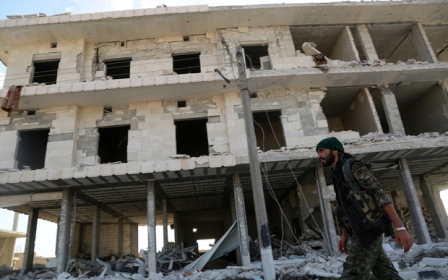Syrian rebels say photos show fleeing IS militants using 'human shields'

Pictures released by a US-backed Kurdish-Arab rebel group appear to show Islamic State (IS) group militants using Syrian civilians as human shields as they attempted to flee the city of Manbij in the province of Aleppo.
The Syrian Democratic Forces (SDF) said the pictures showing a convoy of about 100 vehicles was taken on Friday as militants attempted to head north towards the Turkish border.
The SDF said that it had decided to not attack the convoy as there were civilians in each of the vehicles pictured.
The images were released by the SDF and came a week after the US-backed rebel groups took back control of Manbij after 10 weeks of fierce battles between the SDF and IS militants.
A US coalition spokesman, Colonel Chris Garven, on Tuesday told reporters that 100 to 200 IS militants had gathered members of their families, supporters and civilian hostages as it became apparent that the town was about to fall to the SDF.
Civilians were then placed with the militants in every vehicle in the convoy that headed north and was tracked by SDF fighters and the coalition, Garven said.
The Syrian Observatory for Human Rights, which relies on sources on the ground, also reported that IS had abducted around 2,000 civilians as they attempted to flee north to the Turkish border.
It also reported that the civilians were placed in hundreds of cars that then headed for Jarabalus in North Syria.
The US coalition declared last Friday that Manbij had been liberated from IS control.
Manbij residents were pictured hugging female SDF soldiers as the rebel group chased out IS militants who had administered a strict interpretation of Sharia law in the city.
Images from Manbij after the SDF took control of the city also showed men cutting off beards and women burning face veils.
The US coalition, which has been assisting the SDF with air strikes and special forces personnel, was accused last month by campaigners of indiscriminately killing civilians living in Manbij.
Activists called for widespread protests after dozens of civilians were reportedly killed in US-led coalition air strikes in what one monitor has called the "worst week" for civilians in the two years since the coalition entered the war.
Children were among at least 56 civilians killed on Tuesday in raids by coalition warplanes.
Airwars, a website tracking civilian deaths by the US-led coalition, said in a tweet that week in July was the deadliest for civilians since the coalition began operations against IS.
The raids also drew condemnation from the UN's children agency, which said that "more than 20 children were reportedly killed" in the raids on al-Tukhar.
"Such horrific incidents confront parties to this conflict with their shared responsibility to respect international humanitarian laws that protect children in war," said UNICEF's Syria representative, Hanaa Singer.
The coalition in a statement said they were investigating the claims, but reassured the public that the operation against IS was the most "precise" in the history of warfare.
Government forces bomb Kurdish positions
Meanwhile, Syrian government warplanes bombarded the northeastern city of Hasakeh for the second day on Friday, targeting positions held by Kurdish forces, a monitor and a journalist in the city said.
The journalist said eight air strikes could be heard throughout the day on Friday, mostly focused in the city's southwestern neighbourhoods.
The Syrian Observatory for Human Rights - which monitors the conflict and determines what planes carry out raids according to their type, location, flight patterns and the munitions involved - said the strikes were conducted by government jets.
Most of Hasakeh city, the capital of the northeastern province by the same name, is controlled by Kurdish forces, while the rest is held by fighters loyal to President Bashar al-Assad.
Since Wednesday, clashes between the two forces have rocked the city, leaving 22 civilians - including nine children - five Kurdish fighters and four members of government forces dead, according the Observatory.
Thursday's government raids on Hasakeh were the first time the regime aerially bombarded Kurdish positions.
Middle East Eye propose une couverture et une analyse indépendantes et incomparables du Moyen-Orient, de l’Afrique du Nord et d’autres régions du monde. Pour en savoir plus sur la reprise de ce contenu et les frais qui s’appliquent, veuillez remplir ce formulaire [en anglais]. Pour en savoir plus sur MEE, cliquez ici [en anglais].




